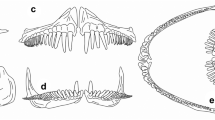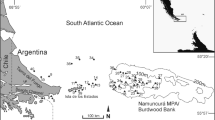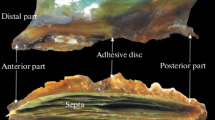Abstract
Ophiurid basket stars belonging to the family Gorgonocephalidae are distributed from the Arctic to the Antarctic and from the shallow subtidal to the deep sea, but their biology remains poorly known. In situ observations at the mouth of the Oslofjord by a remotely operated vehicle showed that Gorgonocephalus caputmedusae had a patchy distribution at 85 to 120 m water depth and frequently occurred in association with the gorgonian Paramuricea placomus and the coral Lophelia pertusa. Morphological and histological studies show that G. caputmedusae is well adapted to capture macroplanktonic prey. Histological examination of the arms revealed the presence of a thick layer of dermal mutable connective tissue which is probably an energy-efficient way to maintain its feeding posture against the current. This layer is connected to the nerve cord suggesting that the passive mechanical properties (stiffness) is controlled by the nervous system. In the distal parts of the arms, each segment has a pair of sticky tube feet and a sophisticated system of spines and hooks, which are connected to muscles and collagenous tendons. In combination, these features were shown, in an experimental flume study, to be used for capturing the locally abundant krill species Meganyctiphanes norvegica. This is the first documentation of G. caputmedusae of this kind.






Similar content being viewed by others
References
Birenheide R, Tamori M, Motokawa T, Ohtani M, Iwakoshi E, Moneoka Y, Fujira T, Minakata H, Notomo K (1998) Peptides controlling stiffness of connective tissue in sea cucumbers. Biol Bull 194:253–259
Byrne M (1994) Ophiuroidea Echinodermata. In: Harrison FW, Chia FS (eds) Microscopic anatomy of invertebrates. Echinodermata. Wiley-Liss Inc., New York, vol 14, pp 247–343
Byrne M, Hendler G (1988) Arm structures of the ophiomyxid brittlestars (Echinodermata: Ophiuroidea: Ophiomyxidea). In: Burke RD, Mladenov PL, Parsley RL (eds) Echinoderm biology. Balkema, Rotterdam, pp 687–695
Casella GT, Bunge MB, Wood PM (2004) Improved immunocytochemical identification of neural, endothelial, and inflammatory cell types in paraffin-embedded injured adult rat spinal cord. J Neurosci Methods 139:1–11
Dearborn JH, Ferrari FD, Edwards KC (1986) Can pelagic aggregation cause benthic satiation? Feeding biology of the Antartic brittle star Astronoma agassizii (Echinodermata: Ophiuroidea). In: Kornicker L (ed) Biology of the Antartic Seas XVII. Antartic Res Ser 44. American Geophysical Union, Washington DC, pp 1–28
Emson RH, Woodley JD (1987) Submersible and laboratory observations of Asteroschema tenue, a long-armed euryaline brittlestar epizoic on gorgonians. Mar Biol 96:31–45
Emson RH, Mladenov PV, Barrow K (1991) The feeding mechanism of the basket star Gorgonocephalus arcticus. Can J Zool 69:449–455
Hendler G, Miller JE (1984) Feeding behavior of Asteroporpa annulata, a gorgonocephalid brittlestar with unbranched arms. Bull Mar Sci 34:499–460
Jägerskiöld LA (1933) Koraller i svenska hav. Norrköpings Tidn. AB, Norrköping, pp 449–458
Jensen A, Fredriksen R (1992) The fauna associated with the bank-forming deepwater coral Lophelia pertusa (Scleractinaria) on the Faroe shelf. Sarsia 77:53–69
Krieger KJ, Wing BL (2002) Megafauna associations with deepwater corals (Primnoa spp.) in the Gulf of Alaska. Hydrobiologia 471:83–90
Mladenov PV, Igsoura S, Asotra S, Burke RD (1989) Purification and partial characterization of an autotomy-promoting factor from the seastar Pycnopodia helianthoides. Biol Bull 176:169–175
Mortensen T (1924) Danmarks fauna, vol 27. Pighude (Echinodermer). Gads Forlag, Copenhagen
Mortensen T (1932) On an extraordinary ophiuroid, Ophiocanops fugiens, Koehler. With remarks on Astergymnotes, Ophiopteron and on an albinos Ophiocoma. Studies of Indo-Pacific euryalids. Medd Dan Naturhist Foren 93:1–22
Motokawa T (1981) The stiffness change of the holothurian dermis caused by chemical and electrical stimulation. Comp Biochem Physiol 70:41–48
Motokawa T (1984) The viscosity change of the body-wall dermis of the sea cucumber Stichopus japonicus caused by mechanical and chemical stimulation. Comp Biochem Physiol 77:419–423
Motokawa T (1987) Cholinergic control of the mechanical properties of the catch-connective tissue in the holothurian body wall. Comp Biochem Physiol 86:333–337
Patent DH (1970) Life history of the basket star, Gorgonocephalus eucnemis (Müller & Troschel) (Echinodermata; Ophiuroidea). Ophelia 8:145–160
Sides EM (1987) An experimental study of the use of arm regeneration in estimating rates of sublethal injury in brittlestars. J Exp Mar Ecol 106:1–16
Vacelet J, Boury-Esnault N (1995) Carnivorous sponges. Nature 373:333–335
Warner GF (1982) Food and feeding mechanisms: Ophiuroidea. In: Jangoux M, Lawrence JM (eds) Echinoderm nutrition. Balkema, Rotterdam, pp 161–181
Wilkie JC (1978) Arm autotomy in brittlestars (Echinodermata: Ophiuroidea). J Zool Lond 186:311–330
Wilkie JC (1984) Variable tensility in echinoderm collagenous tissues: a review. Mar Behav Physiol 11:1–34
Wilkie JC (2002) Is muscle involved in the mechanical adaptability of echinoderm mutable collagenous tissue? J Exp Biol 205:159–165
Wolfe TJ (1982) Habitats, feeding, and growth of the basketstar Astrophyton muricatum. In: Lawrence JM (ed) Echinoderms: Proceeding of the international conference, Tampa Bay. Rotterdam, Balkema. pp 299–304
Young CM, Emson RH (1995) Rapid arm movement in stalked crinoid. Biol Bull 188:89–97
Acknowledgements
Financial support from C.F. Lundströms Stiftelse (to HNS), from Knut and Alice Wallenberg Foundation, the Swedish EPA (MARBIPP) and the County Govenor in Østfold and WWF (to TL). Funding was also received from EU, VR and BBSRC (to MCT)
Author information
Authors and Affiliations
Corresponding author
Additional information
Communicated by M. Kühl, Helsingør
Rights and permissions
About this article
Cite this article
Rosenberg, R., Dupont, S., Lundälv, T. et al. Biology of the basket star Gorgonocephalus caputmedusae (L.). Marine Biology 148, 43–50 (2005). https://doi.org/10.1007/s00227-005-0032-3
Received:
Accepted:
Published:
Issue Date:
DOI: https://doi.org/10.1007/s00227-005-0032-3




